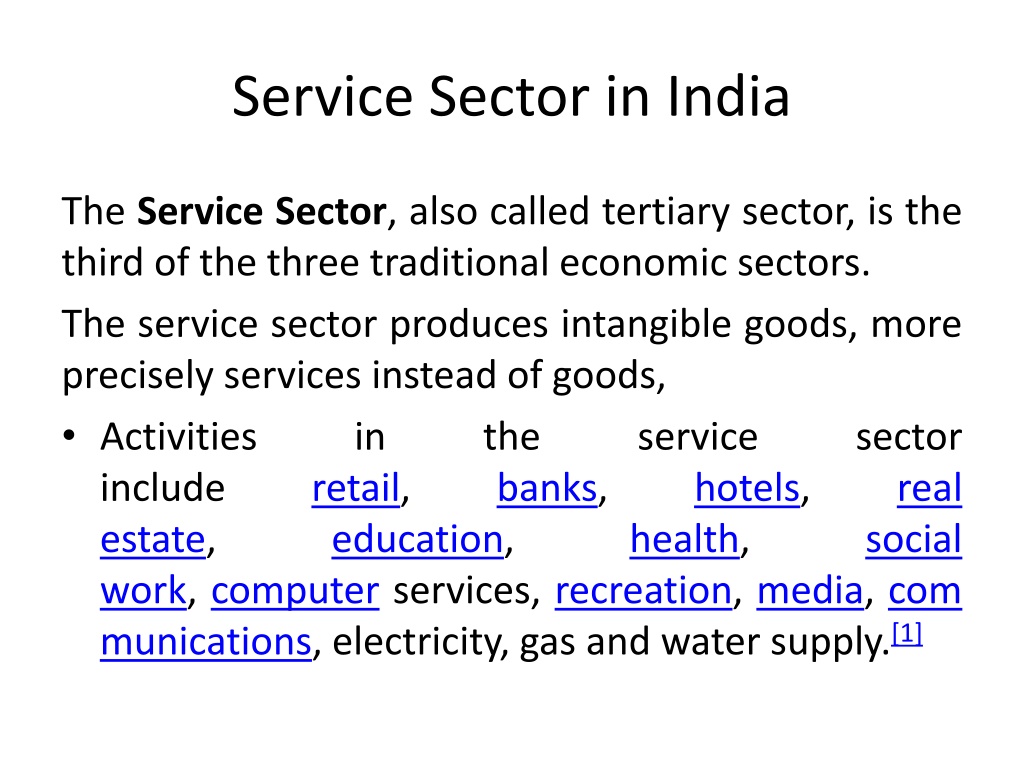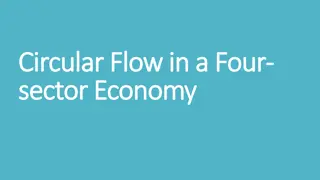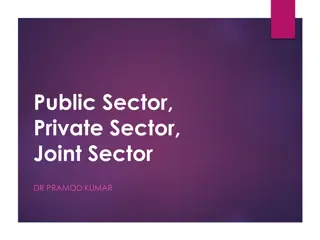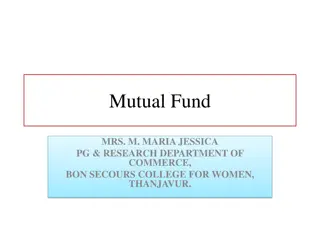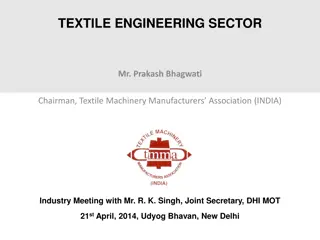Overview of Service Sector in India
The service sector in India, also known as the tertiary sector, has seen significant growth and plays a vital role in the economy. Accounting for around 60% of the GDP, it encompasses various industries like retail, banking, education, and more. The sector has attracted foreign investments, contributed to exports, and generated substantial employment opportunities. The composition includes trade, transportation, finance, and community services, among others, highlighting its diverse contributions to the country's economic landscape.
Download Presentation

Please find below an Image/Link to download the presentation.
The content on the website is provided AS IS for your information and personal use only. It may not be sold, licensed, or shared on other websites without obtaining consent from the author. Download presentation by click this link. If you encounter any issues during the download, it is possible that the publisher has removed the file from their server.
E N D
Presentation Transcript
Service Sector in India The Service Sector, also called tertiary sector, is the third of the three traditional economic sectors. The service sector produces intangible goods, more precisely services instead of goods, Activities in the include retail, banks, estate, education, work, computer services, recreation, media, com munications, electricity, gas and water supply.[1] service hotels, health, sector real social
The services sector, with around 60 per cent contribution to the Gross Domestic Product (GDP) in 2014-15, has made rapid strides during the past decade and a half to emerge as the largest and one of the fastest-growing sectors of the economy. The services sector is not only the dominant sector in India s GDP, but has also attracted significant foreign investment flows, contributed significantly to exports as well as provided large-scale employment.
Composition of Service Sector in India In India, the national income classification given by Central Statistical Organization is followed. In the National Income Accounting in India, service sector includes the following: 1. Trade, hotels and restaurants: a. Trade b. Hotels and restaurants 2. Transport, storage and communication a. Railways
b. Transport by other means c. Storage d. Communication 3. Financing, Insurance, Real Estate and Business Services a. Banking and Insurance b. Real Estate, Ownership of Dwellings and Business Services 4. Community, Social and Personal services a. Public Administration and Defense (PA & D) b. Other services
Role of Service sector in India (i) Share in Net National Product: At present, the service sector contributes the maximum share in country s net national product at factor cost According to 2000-01, 48.5 % share of national income comes from moreover, 22.9% of total working population are employed in this sector. (national income). service sector and
(ii) Helps Industrialisation: The development of industries is dependent on the performance and improvement of transport, communication, electricity, banking etc. in a country. Transport system helps to carry raw materials, finished goods and labourers in their required destination. Communication helps to widen the market industrial goods. Electricity and banking services help to flourish the industries in remote areas.
(iii) Expands Agriculture: Service sector helps to develop the agricultural production by providing facilities. It helps to carry raw materials and finished goods from one place to another. (iv) Removes Regional Imbalances: This sector provides a well-organised transport and communication service. It also provides sufficient banking services along with expansion better network
of education and medical facilities in the backward regions of the country. Thus it helps to wipe out the problem of regional imbalances and disparities within the country. (v) Growth of Market: This sector provides different types of services to both agriculture and industrial sectors. Thu: in other way, it helps to grow the proper markets for both agricultural and industrial
goods finished goods as well as raw materials or semi-finished goods. (vi) High Quality of Life: Better services in the areas of transport and communication, banking education and health etc must help a country to pave the path for economic development by increasing the quality of life or standard of living within the country. It also helps to improve the and insurance,
value of HDI (Human Development Index) of a country. (vii) Increase Productivity: This sector helps the working force by giving sufficient technical education medical facilities. Moreover, a well-organised network of transport system increases the mobility and informations among the workers. All these make the labourer and proper and communication
more productivity (producing capacity of a labourer) will increase simultaneously. (viii) Services Sector Growth and FDI Inflows (ix) Contribution towards Development of Infrastructure and Communication Services: (x) Contribution towards Growth of IT (xi) Travel and Tourism (xii) Media and entertainment (xiii) Health and Education skillful and efficient and thus the
Healthcare Industry The healthcare industry (also called the medical industry or health economy) is an aggregation and integration of sectors within the economic system that provides goods and services to treat patients with curative, preventive, rehabilitative, and palliative care. It includes the generation and commercialization of goods and services lending themselves to maintaining and re- establishing health.
The modern healthcare industry is divided into many sectors. the United Nations International Standard Industrial categorizes the healthcare industry as generally consisting of: Hospital activities; Medical and dental practice activities; "Other human health activities". Classification (ISIC)
Important Trends in Healthcare Industry 1. Rapid Growth 2. Rapid increase in health infrastructure 3. Role of traditional medicines 4. Public and private providers of health services 5. Rising investment in health care facilities 6. Healthcare through insurance 7. Medical tourism
Problems /issues facing the health industry 1. Neglect of Rural Population 2. Inadequate Outlay for Health 3. Social Inequality 4. Shortage of Medical Personnel 5. Medical Research 6. Expensive Health Service
Growth potentials in the health industry 1. Rise n medical tourism 2. Growing health insurance market 3. Growth of telemedicine 4. Large scope to expand health care infrastructure 5. Ayushman Bharat 6. Market size
Tourism Industry The activity of travelling and touring. is basically a set of inter-connected activities of tourists while travelling to a place. And, so tourism as an industry means and covers the same things but from an economic and monetary point of view. Tourism is a very vast, vibrant, dynamic and growth oriented industry. Tourism as an industry is the set of all business activities which serves the needs of tourists while they visit different places by way of tourism, touring or travelling.
Tourism industry therefore can be defined as the set of industries which facilitate by providing infrastructure and products and services and make possible travelling for different purposes and travelling to places of leisure and business interests. Tourism industry is all about providing necessary means to assist tourists throughout their travelling. India s is the world s 7th largest tourism economy in terms of GDP, says WTTC.
India is a large market for travel and tourism. It offers a diverse portfolio of niche tourism products - cruises, adventure, medical, wellness, sports, MICE, eco-tourism, film, rural and religious tourism. India has been recognized as a destination for spiritual tourism for domestic and international tourists. In March 2019, Rs 720 crore had been allocated by Uttar Pradesh towards strengthening the infrastructure for tourism.
India was ranked 7th among 184 countries in terms of travel & tourism s total contribution to GDP in 2017. Travel and tourism is the third largest foreign exchange earner for India.
Important trends in Tourism Industry in India 1. Exponential Growth India s Tourism is ranked at 7thposition in terms of its contribution to World GDP in World Travel and Tourism Council s report in 2017. Large number of people are spending money for vacation abroad or in the country IT Hub.so people are coming for business trips.
Aggressive advertisement campaigns like Atithi Devo Bhava, Incredible India by the tourism Ministry for inviting foreign tourists. 2. India as preferred destination The number of foreign tourists coming to India has increased. Foreign Exchange Earnings (FEEs) from tourism registered a growth of 11.9% during the period January-October 2018 as compared to the same period of the previous year.
3. Various Categories of Tourism (i) Medical Tourism Medical tourism in India is a billion dollar industry that is at its peak. India is a major destination for people around the world seeking medical treatment. Due to the medical sector being backed and promoted by the government, this has flourished significantly in the last few years. By 2020, the income from medical tourism is expected to be around 9 billion USD.
Even in the US, most of the people working in healthcare are Indians. As a result, there is no shortage of skilled Indian medical workers in the world. Couple this with the low-cost, high- quality healthcare in speaking professionals, you get the perfect recipe for excellent medical facilities. This is what attracts tourists. Instead of paying almost 4-5 times the medical expenses in India and English
India, in their country, they can obtain a better, if not equal, level of service in India. For example, open heart surgery costs up to 70000 USD in the UK. And, the same procedure can be performed in India for a maximum of 10000 USD. Due to massive differences in the costs, there is a large influx of tourists visiting India for these purposes.
(ii) Eco-Tourism In layman term, Eco-tourism is simply the form of tourism in which a tourist visits a place without disturbing the respecting the local culture and people. Eco- tourism in India is a new approach taken to preserve the ecosystem and heritage. This type of tourism is largely beneficial to the local people. By directly involving in this, they ensure that the environment and natural resources are protected. environment and
In India, the hotspots for this are common in the western and eastern ghats, Himalayan areas, Kerala, Northeastern states, Andaman and Nicobar islands, and Lakshadweep. The importance of eco-tourism is significantly high. To maintain ecosystem, it is necessary to preserve the flora and fauna, especially those of endangered species. With an increase in tourists, these are threatened. As a result, the government has initiated eco-tourism to counter this issue. the balance of the
(iii) Religious Tourism The birthplace of 4 major religions, namely Buddhism, Hinduism, Jainism, and Sikhism, pilgrimages have been a part of the country since early ages. Along with these, due to the invasion by the Mughals, and Portuguese and French colonializations, religions like Islam and Christianity have been established in India. Tourism to monasteries, temples, mosques, churches, as well as other imprints of other
religiously significant places includes religious tourism. Until recently, this form was mainly domestic. However, developments, these attracting foreigners. Most of the tourism in this domain has been to the state of Tamil Nadu, known for its ancient temples, statues, and caves, etc. due sites to recent started have
(iv) Cruise Tourism With a large capacity for development, cruise tourism in India is an upcoming industry. Being the most luxurious of the world s tourism industry, its effect in India has been limited due to several reasons. However, recent initiatives and developments have opened up a pathway to improve this sector. Cruises are basically ships or boats that provide special amenities like pools, hotels, restaurants, etc along with the
journey from one destination to another. As of now, cruise tourism is limited to river tourism, and other forms of domestic tourism with cruises mainly operating between Mumbai-Goa, as well as to Maldives, Lakshadweep, and a few other places. River tourism in India can be seen in the river Ganges, and in the backwaters of Alleppey in Kerala.
(v) Adventure Tourism Being a modern form of tourism targeting adventure enthusiasts, involves exploring and travelling to remote areas and exotic locations. These activities can include trekking, white water rafting, skiing, surfing, rock climbing, skydiving, and so on. India, being very diverse in terms of even terrains and climates makes several types of adventure tourism possible. The adrenaline pumping adventure tourism
nature of this attracts a large number of tourists from all over India as well as the world. The most notable mentions Himachal Pradesh, The Himalayas, Ladakh, etc. (vi) Wellness Tourism Similar to healthcare, India is a well-known hotspot for spirituality and wellness. With an environment that enhances tranquillity, India attracts quite a number of people for various are Uttrakhand,
activities that are focused on improving ones health and wellness. Body massages, yoga, meditation training, nutrition programs, etc are a few of the services under this category. (vii) Cultural Tourism One major thing that separates India from other countries is its rich culture and heritage. And this is also one of the main reasons why tourists visit the country. With several fairs, festivals, architectural sites, and so on, the cultural
tourism in India is booming and is always going to be a crowd puller. Being ruled by several rulers in the past, they all left behind a piece of their history and heritage leaving an impact on the country. As a result, every region in India has a different array of culture, food, music, and tradition. Some of the major states for these are Tamil Nadu, Uttaranchal, Uttar Pradesh, etc.
(viii) Leisure Tourism Known for the coastal lines, hill stations, and lakes, people visiting India to enjoy these come under the category of leisure tourism. Even though a significant amount of this is domestic, it certainly does attract several foreigners too. The French colony of Pondicherry and the Portuguese influenced Goa are two of the most visited places for its beaches, attracting several
foreigners. Mount Abu, Kullu-Manali, Ooty, Mahabaleshwar, etc are famous hill stations that attract a lot of domestic tourists. 4. Important role of Tourism Ministry and Government The steps taken by Govt. are a} Plans for regional development with the help of tourism where other industries are not in their best.
b} Started one window policy to boost the direct and as well as indirect investment in tourism. c} Plans preservation of cultural, heritage and environment at tourist destinations to attract more tourists. d} Development of infrastructure to meet the present and future needs of tourist.
e} Started different types of luxurious trains like Palace on Wheels, Royal Orient or Deccan Queens. f} Developing basic infrastructure. g} Started overseas offices at different countries to promote India as a tourism destination. h} Proper coordination between the states and central tourism departments been ordered to develop the destinations.
i} Started different packages to attract for those destinations attracting more tourists. j} Developed different Tourism Circuits like Golden Triangle or Buddhist Circuit to attract more tourists. k} ITDC is now taking part in different tourism fairs all over the world. l} Trying to provide best of the services in Air India and in Indian Rail.
m} Building accommodation in Govt. level and encouraging the private companies to invest in accommodation sector by giving them different tax benefits. 5. Encourage growth in other sectors- like handicraft, agriculture horticulture etc 6. Creates Employment opportunities 7. Provide increasing opportunities for long- term investment
National Tourism Policy 2002 OBJECTIVES CREATING AN INDIA TOURISM BRAND POSITION STRATEGIES FOR EFFECTIVE MARKETING: CREATION OF WORLD- CLASS INFRASTRUCTURE POSITIONING AND MAINTAINING TOURISM DEVELOPMENT ENHANCING AND MAINTAINING THE COMPETITIVENESS OF INDIA AS A TOURIST DESTIBATION
The policy document seeks to enhance employment potential within the tourism sector as well as to foster economic integration through developing linkages with other sectors. Broadly the policy paper attempts to: -position tourism as a major engine of economic growth; harness the direct and multiplier effects of tourism for employment generation, economic development and providing impetus to rural tourism;
focus on domestic tourism as a major driver of tourism growth. position India as a global brand to take advantage of the burgeoning global travel and trade and the vast untapped potential of India as a destination; acknowledges the critical role of private sector with government working as a pro- active facilitator and catalyst;
create and develop integrated tourism circuits based on India s unique civilization, heritage, and culture in partnership with states, private sector and other agencies; ensure that the tourist to India gets physically invigorated, mentally rejuvenated, culturally enriched, spiritually elevated and " feel India from within".
Measures for the Development of Tourism in India 1. Positioning Tourism as a National Priority 2. Enhancing India's competitiveness as a tourist destination 3. Improving and expanding product development 4. Creation of World class infrastructure 5. Effective marketing strategies 6. Creating an India tourism brand position 7. Security Measure
